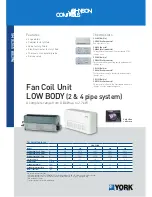
en
19
6.4
Positioning the electric pump
Lower the electric pump into the well carefully in order to prevent damage to the pump and, more especially, the electric cable.
If the pump is installed in the vertical position, make sure that the motor does not rest on the bottom of the well or tank.
If the electric pump is installed in a well, make sure that the distance between the bottom of the well and the lower end of the
motor is at least 1 metre.
If the electric pump is installed in the horizontal position, make sure that the motor is at a safe distance from the bottom of the well
and that the position of the head is not lower than that of the motor support.
For additional information see sections 3.1 and 10.4.
6.5
Electrical connection
The electrical connections must be performed by a qualified installation technician in compliance with the
regulations in force.
Make sure that the supply voltages and frequencies are suited to the characteristics of the electric motor.
Before proceeding, make sure that all the connections (even those that are potential-free) are voltage-free.
Always refer to the motor manual and to the instructions provided with the electric panel.
6.6
Starting the electric pump
For the first pump start-up, the on-off valve should be about one-third of the way open in order to reduce as much as possible the
suction of sand that may be found in the well. If the water is turbid, close the valve some more until the water is clear.
6.6.1
Electric pump direction of rotation
The correct direction of rotation of the shaft is anti-clockwise when facing the delivery side of the pump. The correct direction is
indicated by an arrow on the pump body. In the case of three-phase electric pumps, if a visual check of the rotation direction is not
possible, proceed as follows.
Connect the electric pump and start it. Stop the pump. Reverse the direction of rotation of the motor by switching the position of
two phase conductors. Start the electric pump. The correct direction is the one that delivers the highest pressure.
6.6.2
Checking the purity of the pumped water
After checking the correct direction of rotation, leave the valve about one-third of the way open and check whether the pumped
water is clear and clean. If any sand is present, let the pump run until clean water is delivered.
Open the valve gradually and wait until the water runs clean again. If the water runs clean when the valve is completely open, it
means that the electric pump is ready to be permanently connected to the distribution network.
7.
Maintenance, service and spare parts
Information for maintenance personnel
Before performing any maintenance operations on the electric pump, make sure that the motor is voltage-
free.
Maintenance operations must be performed by skilled and qualified personnel only. Use suitable equipment
and protection devices. Observe the accident prevention regulations in force. If you need to drain the pump,
make sure that the drained liquid does not cause damage or injuries.
The pump does not require any scheduled routine maintenance. Extraordinary maintenance may be necessary in order to clean the
liquid end or replace any worn components.
Please contact our Sales and Service Department for any requests.
Always refer to the motor manual.
7.1
Spare parts
Always specify the exact pump/electric pump type and identification code when requesting technical
information or spare parts from our Sales and Service Department.
Use only original spare parts to replace any components. The use of unsuitable spare parts may cause
malfunctions, damage and injuries.
8.
Troubleshooting
Information for users and maintenance personnel
PROBLEM PROBABLE
CAUSE
POSSIBLE SOLUTION
The electric pump does not start.
The main switch is on.
No power supply
Restore the power supply
Triggering of thermal relay or motor
protector found in the electric control
panel.
Reset the thermal protector
WARNING
WARNING
Содержание Z6 Series
Страница 115: ......
















































